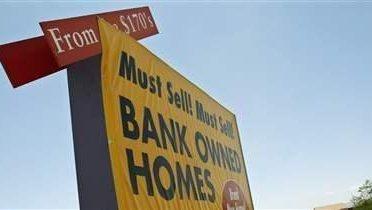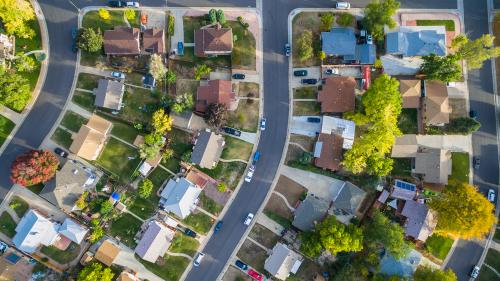Editor’s Note: For Campaign 2012, Martin Baily wrote a policy brief proposing ideas for the next president on stimulating America’s economic growth. The following paper is a response to Baily’s piece by Karen Dynan. Elisabeth Jacobs also prepared a response arguing that the next president should act forcefully to promote economic security and opportunity in America.
As Martin Baily notes, the bleak state of the housing market is a significant factor holding back the economy right now. We have seen almost no recovery in housing since the severe slump that began in 2006: single-family housing starts have remained below 30 percent of their peak reading for more than three years, and residential construction employment has stayed near its lowest level since the early 1990s. Home prices plunged between 2006 and 2008 and have continued to edge down since then such that they now stand one-third below their high. Because housing accounts for such a large share of many households’ assets, the associated decline in housing wealth is a major channel through which the housing bust has depressed overall demand.
In past business cycles, the housing sector has often led the recovery. Residential investment typically turns around a couple of quarters after the beginning of a recession, rising sharply and surpassing its peak a year thereafter. Although there are some signs that the housing market has finally hit bottom, conditions hardly look poised for a sharp rebound. Thus, the next administration will need to focus not only on ways, as Baily urges, to sustain fragile growth but also on the problems in the housing sector.
The lack of recovery in the housing market reflects several interrelated problems. To begin with, the demand for housing remains very depressed. High rates of job loss, soft wage growth and depleted financial reserves have reduced both the desire and wherewithal of Americans to become homeowners. One contributing factor has been low rates of household formation among younger households: over the past several years, the share of adults ages 25 to 34 living in their parents’ homes has jumped to one in seven, up from one in ten in 2000.
In addition, many households continue to experience mortgage distress. According to Corelogic, 23 percent of the roughly 50 million residential mortgages in the United States are currently “underwater,” meaning that the amount owed exceeds the value of the underlying home. More than two-thirds of these mortgages are not in default according to the Federal Reserve Board. Even so, the sheer number of underwater households implies that the aggregate rate of default is high. Moreover, even those underwater borrowers who are current on their mortgage payments are likely paring back their spending in order to repair their balance sheets, contributing to the softness in overall economic activity.
These high rates of mortgage distress have resulted in enormous numbers of foreclosures. The Federal Reserve Bank of New York estimates that about 8 million consumers have faced a new foreclosure filing since the beginning of 2007. The pace of new foreclosures has dipped of late, but the backlog of severely delinquent loans is large, and new foreclosures are expected to pick up again as mortgage servicers overcome various deficiencies that have hindered their ability to deal effectively with such loans. In addition to causing hardship for individual households and their communities, the high rate of foreclosure is contributing to the oversupply of housing, as they imply a large number of distressed properties coming to market. Corelogic estimates that a “shadow inventory” of 1.6 million distressed properties likely to be put on the market in the future.
These housing market problems have been exacerbated by lenders’ reluctance to make mortgage loans. Tight credit conditions are not only holding people back from becoming homeowners, they are making it difficult for many existing homeowners to save on their mortgage payments by refinancing into lower-rate loans. Negative equity, weak incomes and cautious bank behavior have stood in the way of many potential refinancers obtaining historically low interest rates in refinancing—or refinancing altogether. An important channel through which easier monetary policy typically affects the economy, is clogged.
There are a number of constructive housing policy options underway or on the table for the near future. These include measures that attempt to reduce foreclosures, programs aimed at situations where even an aggressive reduction in mortgage payments would still leave the homeowner in an unsustainable situation and efforts to facilitate refinancing. Even when taken collectively, however, the foreclosure-related and refinancing programs are unlikely to spur a rapid housing recovery by themselves, as even the more significant individual measures are expected to affect hundreds of thousands of mortgage borrowers when the scope of the problem is in the many millions.
With the financial crisis having revealed severe flaws in the U.S. housing finance system, reforms to this system represent a major area of needed additional housing policy for the next administration. Regulatory changes that will reduce risk-taking in the mortgage lending practices of financial institutions are already underway. However, policymakers have yet to deal with reforming and/or replacing Fannie Mae and Freddie Mac, which are thought by many to have helped precipitate the crisis. Various reform proposals have been developed, including several presented in a white paper released by the U.S. Departments of Treasury and Housing and Urban Development in February 2011, but the issue is so large and contentious that no action is expected before the election.
Reform of these institutions should be a priority in the next administration. Uncertainty over the future housing finance system is deterring the housing recovery by inhibiting the ability of households, builders, and lenders to plan and move forward. It is also worth noting that probably the best thing that policy could do for housing is to bolster overall economic growth, which would stimulate housing demand, support housing prices and relieve strains on distressed homeowners. This observation brings us full circle to Baily’s paper and its suggestions for fostering the broader recovery.




